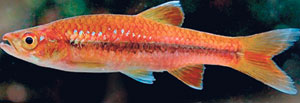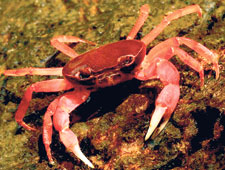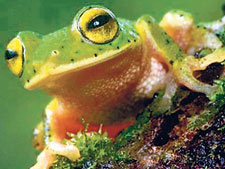In the 1990's, members of the Wildlife Conservation Society of Galle discovered a species of small freshwater fish in a stream in Wilpita in the Matara district. Conducting a survey recently, they couldn't find the fish Raspora Wilpita, as it was named, in the stream where it was discovered. It was later located in streams deeper in the rainforest. This fish that prefers shady streams may have been affected due to agrochemical use, changes in the vegetation around the stream or even invasive plants.
Such are the adverse effects on fragile ecosystems which we may little consider. With 2010 being declared as the International Year of Biodiversity by the United Nations, Sri Lanka needs to look afresh at conservation strategies to protect its wealth of biodiversity.
 |
| Raspora Wilpita.
Pic courtesy Wildlife Conservation Society of Galle |
Biological diversity - or biodiversity - is the term given to the variety of life on Earth and the natural patterns it forms. The biodiversity we see today is the fruit of billions of years of evolution, shaped by natural processes and, increasingly, by the influence of humans. It forms the web of life of which we are an integral part and upon which we so fully depend. But this valued biodiversity on earth is threatened by our own activities.
Despite its relatively small land area of 65,610 sq.km, Sri Lanka is blessed with exceptionally high diversity of animals and plants. This has led to the country being recognized together with India's Western Ghats region as a biodiversity hotspot. Only 34 such hotspots have been identified in the whole world.
"Endemic biodiversity in Sri Lanka is exceptionally high," points out Vimukthi Weeratunga, head of the Biodiversity Unit of the International Union of Conservation of Nature (IUCN) Sri Lanka. These species we call endemic do not occur anywhere else in the world, so if they disappear from Sri Lanka, they will be gone forever. According to the IUCN's Red List which is accepted as the status of world species; 27 % of the flowering plants, 84 % of the amphibians, 50% of the reptiles, 54 % of the fresh water fish, 85 % of the land-snails are endemic to Sri Lanka.
Among the most fascinating creatures found in the country are freshwater crabs for all of the 51 species discovered in Sri Lanka are not found elsewhere in the world. "100% of the freshwater crabs are endemic to the island, but public interest in freshwater crab conservation is unfortunately rather low," says Weeratunga highlighting the need to focus more attention on invertebrate animals, which often escape our attention. Amphibians are another group where Sri Lanka records one of the highest rates of endemism in the whole world. But 17 of these species have also become extinct putting Sri Lanka top of the list of places in the world that have lost the highest number of amphibians in the last century.
 |
The above statistics clearly show that the wealth of our biodiversity lies in these small creatures. But most of the conservation plans are targeting the protection of charismatic animals like elephants or leopards. Deputy Director of the Department of Wildlife Conservation H.D. Ratnayake says the department takes the approach of conserving habitats as a whole rather than focusing on small animals individually. "When the ecosystem is protected, the small species living in them will automatically be protected," Ratnayake said.
As an island, Sri Lanka is blessed with vast number of ecosystem diversity due to its geo-climatic variations. Ecosystem diversity is an important part of biodiversity as every ecosystem has its own unique species diversity. Conservation focused on ecosystem diversity will protect not only the species that inhabit those habitats but also interaction of habitat specific species and their biophysical components as well.
Sri Lanka also has an unfair balance of protected areas with the majority located in the dry zone. More than 75% of the total endemic species are restricted to the rainforests of the wet zone and the cloud forests of montane regions. Of the 830 endemic flowering plants, 92% are found in lowland tropical forests that cover only 2% of the country's total land area. But the wet zone has only a few protected areas. To make the matter worse, there is huge human pressure on these biodiversity rich rain forests that continue to shrink. Encroachment has been a huge problem and the lowland tea plantations continue to spread, further fragmenting the remaining wet zone forests. This fragmentation could affect the genetic diversity of the species which is another very important aspect of biodiversity. When isolated, the species trapped in a small area continue to breed with a small number of species, hence losing the chance to mix with other species of its own.
The other threats to Sri Lanka's biodiversity, habitat loss notwithstanding are the extensive use of agro-chemicals that pollute the water and soil eradicating the small animals. The ecosystems in the wet zone are so fragile, that removing one factor can be catastrophic.
However, there are discoveries and rediscoveries of animals that strengthen the pool of Sri Lanka's biodiversity. "We had re-discovered Omestonii's Oak blue butterfly after 100 years. It was believed to be gone extinct. The butterfly was discovered in 1917 in Nakiyadeniya by a naturalist named Omestonii, but when he returned to Sri Lanka in 1927, the habitat was destroyed for rubber plantations and the butterfly couldn't be located raising fears that it had become extinct. There was much research carried out from then, but until recently it escaped the researchers' watchful eyes. "The availability of new tools and the renewed enthusiasm of researchers is a good sign for biodiversity with quite a number of new species discovered in recent years," commented Madhura de Silva - the president of the Wildlife Conservation Society of Galle.
 |
| Pic by Vimukthi Weeratunge |
The Biodiversity Secretariat established under the Environmental Ministry has also been doing a commendable job in encouraging new research to focus more on small creatures. One such project carried out by the Wildlife Conservation Society of Galle which was funded by the Biodiversity Secretariat ended up discovering four new species. The Biodiversity Secretariat had also published a few guide books for amateur researchers.
"We need a clear conservation plan to protect our biodiversity and it should goes beyond the traditional approach of saving habitats," says Weeratunga. He suggests modern mechanisms such as the River Basin conservation approach where the basin of a selected river can be developed. A river goes through many ecosystems from ridges of highlands to ocean reefs - different habitats which house a variety of species.
He also points out the importance of community participation, where human participation for conservation action is very important for the protection of biodiversity.
The loss of biodiversity threatens our food supplies, opportunities for recreation and tourism, and sources of wood, medicines and energy. Imagine the sudden disappearance of Blue Whales from Mirissa. It would be catastrophic for the budding tourism industry based on whale-watching. Likewise its economic value too is huge.
"Conservation of biological heritage of Sri Lanka is not only the job of conservationists, but also every single citizen has an important role to play," urges Weeratunga. Thoughts to ponder as we begin 2010.
| Species found in Sri Lanka |
| |
Total |
Endemic |
| Dragonflies |
120 |
53 |
| Butterflies |
244 |
20 |
| Freshwater Crabs |
51 |
51 |
| Flowering plants |
3400 |
830 |
| Land snails |
246 |
204 |
| Freshwater fish |
84 |
44 |
| Amphibians |
111 |
93 |
| Crocodiles |
2 |
0 |
| Tortoises |
3 |
0 |
| Turtles |
5 |
0 |
| Snakes |
85 |
47 |
| Agamid Lizards |
18 |
15 |
| Chameleon Lizards |
1 |
0 |
| Monitor Lizards |
2 |
0 |
| Skinks |
29 |
22 |
| Geckos |
41 |
29 |
| Lacertid Lizards |
2 |
0 |
| Marine Snakes |
15 |
0 |
| Birds |
492 |
28 |
| Mammals |
91 |
16 |
| Source: IUCN |
Wider recognition for Rio deal
In 1992, the largest-ever meeting of world leaders before the Copenhagen summit took place at the United Nations Conference on Environment and Development in Rio de Janeiro, Brazil.
A historic set of agreements was signed at the "Earth Summit”, including two binding agreements, the Convention on Climate Change, which targets industrial and other emissions of greenhouse gases such as carbon dioxide, and the Convention on Biological Diversity, the first global agreement on the conservation and sustainable use of biological diversity.
The biodiversity treaty gained rapid and widespread acceptance. More than 150 governments signed the document at the Rio conference, and since then more than 187 countries have ratified the agreement. |



